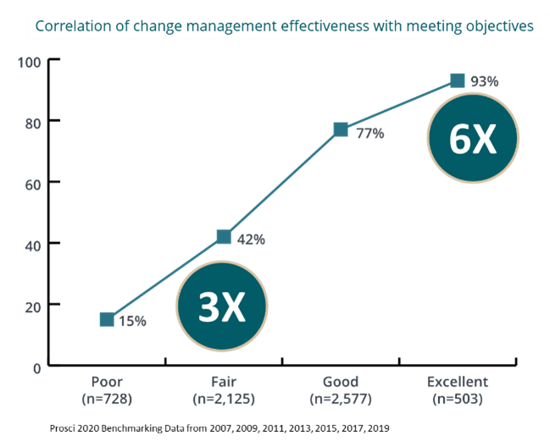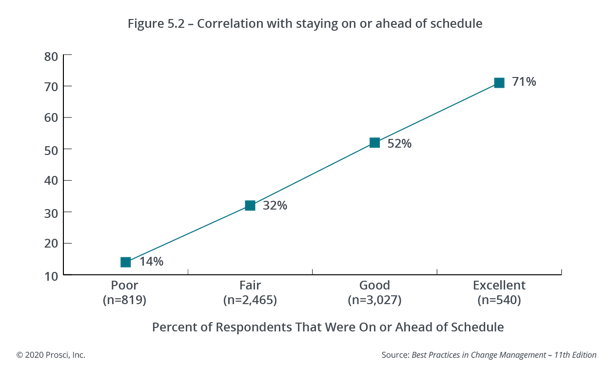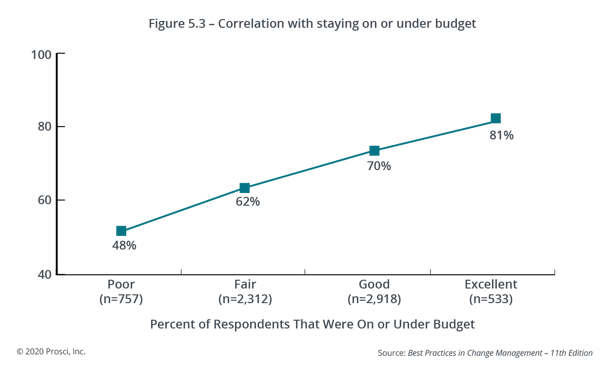Make the Case: Connect Change Management to Project Results

2 Mins
Updated: August 17, 2023
Published: March 8, 2016

As change managers, we often find ourselves explaining what change management is and why it is important. This justification can sometimes feel like a never-ending cycle, which can drain our passion and energy. But we have compelling data to keep in our back pockets when we are convincing our senior leaders, project managers or clients why they should invest in change management. This data is the correlation of change management effectiveness and achieving project outcomes. Because the truth is that today, everyone wants outcomes.
Change Management Research
Since 2007, Prosci has analyzed the correlation between change management effectiveness and what we all want from our projects: outcomes. The correlation has been positive since we started this research, and has even increased in strength over time.
Here’s what we found in the most recent Best Practices in Change Management research:

Only 15% of projects with poor change management achieved their project outcomes, whereas 93% of projects with excellent change management achieved their project outcomes. The bottom line: projects with excellent change management are more than six times as likely to achieve their outcomes than projects with poor change management.
It gets even better! We also see positive correlations between change management effectiveness and projects staying on time and on budget.


Effective Change Management
If you’re a change manager, these correlations probably don’t surprise you. Instead, they validate what you already know from your experience. But you may be wondering how we determined what qualifies as poor, fair, good and excellent change management. During the research study, each research participant ranked twelve factors of change management effectiveness from strongly disagree to strongly agree. The overall scores determined their level of change management effectiveness.
Factors of change management effectiveness
- We applied a structured change management process
- We had sufficient resources on the team to implement change management
- Our change management activities were customized and scaled to fit the change and the organization
- Our change management team had the necessary training and expertise in change management
- We integrated our change management activities into the project plan
- Our business leaders fulfilled their roles as effective sponsors throughout the entire project
- We implemented an effective communications plan
- People managers engaged in the change and effectively coached their employees through the change process
- We provided the necessary training to employees on new processes, systems and job roles
- Our senior leaders and people managers managed resistance to change effectively
- We measured adoption and usage, and our overall performance in meeting project objectives
- We effectively reinforced the change with employees through recognition, performance measurement and celebrations
How to Use the Change Management Data
You can use this data four ways when making the case for change management:
1. Appeal to senior leaders
When we work with senior leaders, these correlation graphs usually make an appearance in the first 10 minutes of our conversation. Why? Because it appeals to the goals and mindsets of executives—investing in what gets results. We also like to sneak in that their involvement as active and visible sponsors of change is a major part of "excellent change management" and, therefore, the results. The adage is that a picture is worth a thousand words, but in my experience, these graphs can be worth tens of thousands of dollars in funding and the immeasurable value of senior leaders who engage in change management.
2. Overcome objections to change management
Common objections to change management include, "It will slow down the project" and "It's an unnecessary overhead expense." Not only does change management correlate with achieving results, it also correlates with projects coming in on time and on budget. The data clearly refutes these common objections.
3. Secure funding and resources for change management
Build the Best Practices in Change Management research into your business case for change management when you’re trying to secure change management funding and resources for a project. Connecting these resources to greater effectiveness and a greater likelihood of achieving outcomes makes a compelling case to fund change management.
4. Get a seat at the project table
Do you have to elbow your way into project team meetings? Many change managers do. Use the data to appeal to project leaders by connecting what you do to what they care about—delivering results on time and on budget.


